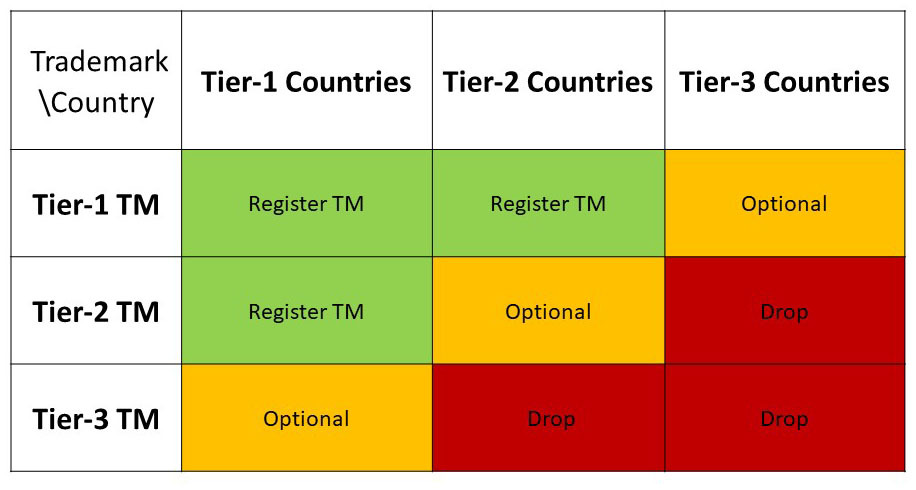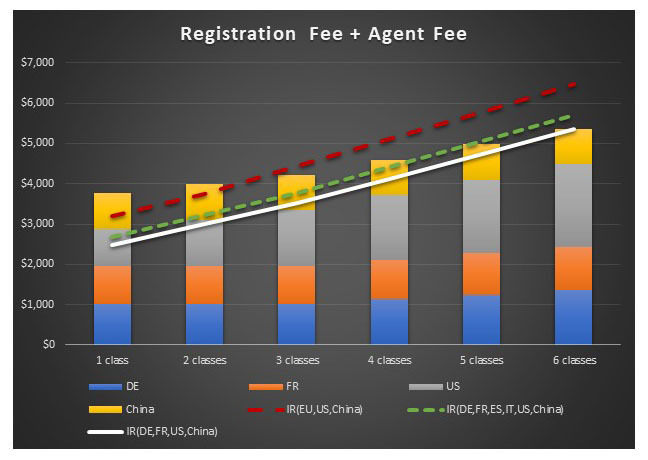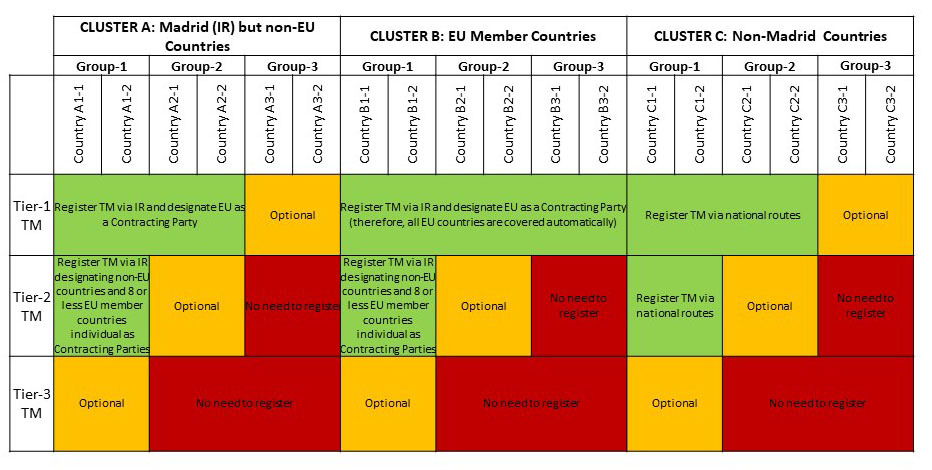
Making Trade Mark Decisions Based on Cost Considerations: A Model for Action

In environments where budgets are finite, creating a resilient, quantifiable methodology for making strategic filing decisions is key.
While companies with deep pockets can afford to file numerous marks without having to choose between occupying the market or testing the strength of the contemplated sign, for those with a more modest budget, the cost of creating, maintaining and defending a trade mark portfolio can quickly add up, leading to a poor return on investment (ROI), if not planned and managed carefully. There is thus a pressing need for such companies to understand the costs associated with different strategies in order to optimise their ROI. Even in large enterprises, management are increasingly keen to know which strategy will provide the best ROI.
Consequently, it can be extremely helpful for companies of all sizes to develop a quantifiable methodology based on their specific needs and requirements when determining whether to file and if so, where and under which route.
This article sets out measurable guidelines to help corporate marketing managers and trade mark attorneys more easily manage daily tasks when dealing with trade mark strategies, especially when under budget constraints. These guides focus mainly on the primary cost aspects and thus, in practice, may need to be balanced with additional factors that have indirect cost implications.
First steps
In order to properly develop a sound trade mark strategy, a corporation must first clarify the key objectives of investing in its trade mark portfolio, which may change over time and under different business circumstances. The following are a few possible scenarios.
If your company’s objective is brand recognition to promote sales and services, you would target countries where you currently sell either directly or indirectly (eg, through channel partners, resellers or distributors) or plan to sell in the next few years. Alternatively, if your company’s objective is revenue or market share protection and the reduction of counterfeits and knock-off goods, then you should target countries where such infringement is rampant and the local government respects and cooperates with trade mark enforcement. Some companies face both issues and thus would likely adopt a strategy that balances these two approaches, developing a mixture of offensive and defensive portfolios depending on the specific country.
How to segment a trade mark portfolio to obtain a repeatable result
Trade mark budgets must typically cover filing, maintaining and defence expenses. Our strategy can be applied to all of these categories using the following streamlined three step approach:
-
step 1: classify trade marks into tiers;
-
step 2: segment countries into groups; and
-
step 3: determine in which countries to register the trade mark based on the first and second steps.
More specifically, the first step is to classify each of your trade marks into three tiers, defined as follows:
-
Tier-1 trade marks – high-value trade marks. This tier usually includes house marks or marks associated with a high percentage of your revenue, and those marks that are highly strategic to a company (the so-called ‘must-have’ trade marks).
-
Tier-2 trade marks – medium-value trade marks. This tier usually includes marks that are used with some of your products or marks with moderate strategic value (ie, so-called ‘nice-to-have’ trade marks).
-
Tier-3 trade marks – limited value or optional trade marks. This tier usually includes marks for products or services associated with small or declining revenue, and marks that are deemed non-strategic or that will not be used going forward.
The second step is to segment the countries of interest into three groups. The precise groupings may vary from one trade mark to another, although for simplicity, you can assume that they are the same for all your marks:
-
Group-1 countries – includes countries with a high revenue for the specific mark, with revenue in several key flagship products or services associated with the specific mark or that are strategic now or will likely become so within the next few years.
-
Group-2 countries – includes countries with medium revenue for the specific mark, with some revenue for a few non-flagship products or services associated with the specific mark or that are somewhat strategic now or will become so within the next few years.
-
Group-3 countries – includes countries where little or no revenue is generated now and/or little is likely to be generated for the next few years, or countries that are not or are unlikely to become strategic markets within the next three years.
The next step, the third step, is to formulate a trade mark registration strategy based on these three tiers and the three country groups to evaluate the cost impact depending on which trade marks you decide to register and in which countries.
We propose a matrix approach (see Figure 1) that recommends keeping active (ie, registering, renewing and defending) Tier-1, Tier-2 and Tier-3 trade marks in a decreasing number of countries. For simplicity, we assume that the country groups are the same for all three trade mark tiers:
-
Keep Tier-1 trade marks active in Group-1 and Group-2 countries but optional for Group-3 countries (depending on your total budget).
-
Keep Tier-2 trade marks active in Group-1 countries and optional for Group-2 countries but drop (ie, do not register or renew) in Group-3 countries.
-
Make the registration of Tier-3 trade marks optional for Group-1 countries but drop these in Group-2 and Group-3 countries.

Figure 1. Trade mark filing/renewal/defence strategy based on trade mark tiers and country groups
This strategy is easy to understand, simple to implement and should yield consistent results in trade mark decisions. However, even after you have chosen the countries for each trade mark, there are still various routes available. These include:
-
the national route of one separate application per country before the national IP office;
-
the regional route of one single application for all the country members of a regional organisation (eg, EU trade marks from the EUIPO); or
-
the international route through international registration via the Madrid System managed by the WIPO with the possibility of either designating the European Union as a contracting party or designating each EU member state of interest individually as a contracting party.
Therefore, besides the three-step process to determine the countries in which to register your trade marks, corporations should also develop quantifiable guidelines to establish which route will be the most cost efficient.
Trade mark registration routes to reduce total filing costs
Instead of looking at all aspects of developing and maintaining a trade mark portfolio, here we focus on filing costs to illustrate our methodology. Trade marks maintenance and defence strategies can follow a similar approach. In addition, as mentioned above, we use EU trade marks as an exemplary regional system – the same regional approach applies to other regional trade mark regimes. For countries covered by the Madrid System, marks can be registered using the international registration route. However, in certain scenarios it may be more cost effective to choose an individual national registration route instead.
In addition, if you do select the international registration route, depending on how many EU member states are strategic, you can reduce your total filing costs by designating individual EU member countries instead of the European Union. The following example illustrates this quantifiable decision process.
EXEMPLARYTM has its base mark application/registration filed in Japan. The rights holder would like to expand the mark to Germany, France, the United States, China and a few other optional EU member states such as Spain and Italy, provided that the budget allows this. If EXEMPLARYTM is a pending or newly registered mark, the owner will need to assess whether it is sensible to file an international registration given that during the first five years of the international registration, this and all extensions will be subject to central attack.
Therefore, if the base mark EXEMPLARYTM in Japan fails or is cancelled during this period for any reason, in whole or in part, the international registration and all extensions will be cancelled to the same extent, unless the rights holder can transform the extensions into national applications. Even if this is possible, these would be subject to national examination and national filing fees in each country.
Many companies will still choose to extend an international registration on a relatively new application or registration, with the knowledge of a potential increased cost if a central attack prevails. In this case, we assume the base mark EXEMPLARYTM in Japan has no apparent issues and is unlikely to be challenged or cancelled.
We then evaluate:
-
the national route of one separate application per country before the national IP office;
-
if we choose the international registration route, whether we should designate the European Union or individual EU countries as the contracting party in order to reduce initial filing costs.
Figure 2 depicts the total cost (including government fee plus an exemplary flat agent fee of $700 for national filings and $1,000 for regional or international filings) for an increasing number of classes. The blue, orange, grey and yellow stacked column represents the case of registering the trade mark via a national route individually in Germany, France, the United States and China, respectively (exemplary countries). The white solid line represents registration via the international route through an international registration designating the exemplary countries. The red dashed line represents the case via an international registration designating the European Union, the United States and China.
As soon as there are three or more countries to be covered, the international route via an international registration is seen to be more advantageous in terms of total cost compared to the individual national route (the exact number of countries may vary if your individual agent fees differ significantly from our assumed fee structure). Since we are trying to expand our base mark EXEMPLARYTM from Japan to between four and six additional countries, an international registration is the recommended route. However, if you need only file in one or two countries, you are better off cost-wise to register the trade mark individually in those countries.
In addition, when filing EXEMPLARYTM in the exemplary countries using the international route via an international registration, if you designate the European Union as a contracting party, the cost of filing the international registration designating the European Union, the United States and China (represented by the dashed red line) is significantly higher than the cost of an international registration designating each EU member state (ie, Germany and France), as well as the United States and China individually (represented by the solid white line). In fact, if you add a few optional EU member states (eg, Spain and Italy), the total cost of an international registration including Germany, France, the United States, China, Spain and Italy (represented by the dashed green line) is still less than the cost of designating the European Union as a contracting party. Since the incremental cost of designating additional individual EU countries via an international registration is approximately $100 per country, the total international registration cost – even after adding another four or five EU member states (ie, eight to nine total EU member states) when designating individual EU member countries – is still lower than designating the European Union as a contracting party. Therefore, designating as many as eight individual EU member states via an international registration has a cost advantage compared to designating the European Union as a contracting party for your international registration.

Figure 2. International registration route versus national route and regional route
Using a similar approach, we find that it is typically more cost effective to choose the EU trade mark route when looking to register a trade mark in three or more EU member states. On the other hand, if you need only register in two or fewer EU member states, you are better off cost-wise by registering in the individual EU member states – although you may arrive at a slightly different conclusion if your agent fees differ significantly from our assumption. Each company should use their actual cost numbers to find out the optimum route for their own specific scenario.
We now apply these guidelines to our trade mark registration strategy to include recommended filing routes. Again, these principles also apply to trade mark maintenance and defence decisions. We first categorise our trade marks into three tiers (Tier-1, 2 and 3 trade marks). We then need to sort the countries into three groups (Group-1, 2 and 3 countries). Meanwhile, we also need to choose the best route (ie, national, regional or international).
Figure 3. Low-cost filing route for Madrid and Non-Madrid System countries
Figure 3 depicts a portfolio with Tier-1, 2 and 3 trade marks listed in the first column on the left-hand side and a few exemplary countries listed across the top row as the Group-1, 2 and 3 countries. We also aggregate countries that belong to the Madrid System but are not members of the European Union into Cluster A. Trade mark registrations in Cluster A countries can be made through an international registration designating these countries or via a national route. Separately, EU member states are aggregated into Cluster B. These states have the most flexibility – trade mark applications within the EU territory can be filed through the national route (local application in each country of interest), the regional route (one single application (ie, EU trade marks for the 27 EU member countries)) or through the international route via an international registration (based on a base national mark), bearing in mind that as part of an international registration you will be able to designate the European Union as a contracting party or the EU member states of interest individually as contracting parties. Non-Madrid countries are aggregated into Cluster C and the trade mark filing route in these countries is limited to national registrations.

In Figure 3, we list two exemplary countries under each Group (eg, Country A1-1 and Country A1-2 under Group-1 in Cluster A; and Country A2-1 and A2-2 under Group-2 in Cluster A). This is simply for illustration purposes and the actual number of countries in each group may vary anywhere from zero to as many as a couple of hundred, depending on the breadth of the company’s trade mark portfolio.
In the following section, we examine each trade mark tier under each cluster to illustrate how to use Figure 3 to help determine where to file and which filing route to select purely from a cost-saving perspective.
Learn how DynaOptics developed a robust trade mark strategy to successfully expand overseas
Cluster A – countries under the Madrid System that are non-EU members
Since the guideline is to register Tier-1 trade marks in Group-1 and Group-2 countries, it is almost certain that three or more countries will need to be covered. Therefore, an international registration route would cost less than a national route based on the analysis set out in Figure 2. In addition, more than eight EU member countries will likely need to be covered because Tier-1 trade marks are the most important marks (eg, house marks). Therefore, designating the European Union via an international registration generally means lower costs and that some of the risks involved in filing an EU trade mark can be overcome through the conversion mechanism. As a result, we recommend registering via an international registration and designating the European Union as a contracting party for Group-1 and 2 countries. Whether to register in Group-3 countries is optional.
For Tier-2 trade marks, the guideline is to register in Group-1 countries. It is likely that three or more countries will need to be covered in addition to your base mark since Tier-2 trade marks are moderately important. Thus, using the international registration route would result in a lower cost than the national route. However, only a handful of EU member countries likely need to be covered. As a result, we recommend registering via an international registration, which designates non-EU countries and eight or fewer EU member states individually as contracting parties. Registration in Group-2 countries is optional and there is no need to register in Group-3 countries.
Whether to register Tier-3 trade marks in Group-1 countries is also optional. If you do decide to register a trade mark, the national route with only one or two countries would be recommended. If you decide to use the international registration route, designating each EU member country as contracting parties individually is likely to be cheaper than designating the European Union as a single contracting party. On the other hand, there is no need to register in Group-2 or 3 countries.
Cluster B – EU member states covered under an EU trade mark
Since countries in Cluster B are all EU member states, they are all covered under the single title of EU trade mark. Thus, Tier-1 trade marks would automatically be registered in all countries within Cluster B, benefiting from the guidelines for Cluster A, which recommends an international registration and designates the European Union as a single contracting party. As a result, Group-1, 2 and 3 countries are automatically covered.
For Tier-2 trade marks, similar to the guidelines set f
